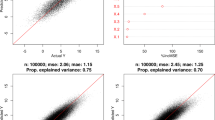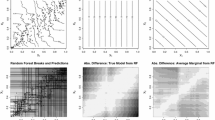
Overview
- Offers an application-oriented guide to CART trees and random forests
- Covers a range of practical issues, and provides real-life examples and R codes
- Particularly valuable for statisticians wishing to use random forests in applied work, or to analyse datasets, but also for scientists from other fields, as it is accessible for non-statisticians
Part of the book series: Use R! (USE R)
Access this book
Tax calculation will be finalised at checkout
Other ways to access
About this book
This book offers an application-oriented guide to random forests: a statistical learning method extensively used in many fields of application, thanks to its excellent predictive performance, but also to its flexibility, which places few restrictions on the nature of the data used. Indeed, random forests can be adapted to both supervised classification problems and regression problems. In addition, they allow us to consider qualitative and quantitative explanatory variables together, without pre-processing. Moreover, they can be used to process standard data for which the number of observations is higher than the number of variables, while also performing very well in the high dimensional case, where the number of variables is quite large in comparison to the number of observations. Consequently, they are now among the preferred methods in the toolbox of statisticians and data scientists. The book is primarily intended for students in academic fields such as statistical education, but also for practitioners in statistics and machine learning. A scientific undergraduate degree is quite sufficient to take full advantage of the concepts, methods, and tools discussed. In terms of computer science skills, little background knowledge is required, though an introduction to the R language is recommended.
Random forests are part of the family of tree-based methods; accordingly, after an introductory chapter, Chapter 2 presents CART trees. The next three chapters are devoted to random forests. They focus on their presentation (Chapter 3), on the variable importance tool (Chapter 4), and on the variable selection problem (Chapter 5), respectively. After discussing the concepts and methods, we illustrate their implementation on a running example. Then, various complements are provided before examining additional examples. Throughout the book, each result is given together with the code (in R) that can be used to reproduce it. Thus, the book offers readersessential information and concepts, together with examples and the software tools needed to analyse data using random forests.
Similar content being viewed by others
Keywords
Table of contents (5 chapters)
-
Front Matter
-
Back Matter
Reviews
“The level of accuracy can be hard to beat. … The worked examples at the end of each chapter are perhaps the most useful feature of this text.” (John H. Maindonald, International Statistical Review, June 2, 2021)
Authors and Affiliations
About the authors
Robin Genuer is an Assistant Professor of Statistics at the University of Bordeaux and a member of the Inserm U1219 and Inria Bordeaux Sud-Ouest research centres.
Jean-Michel Poggi is a Professor of Statistics at the University of Paris and member of the LMO, the Orsay Mathematics Laboratory (University of Paris Saclay).
They have both produced various research works on random forests and have given numerous lectures and talks on the subject. They have also taught postgraduate and doctoral courses for a variety of audiences. Lastly, they have developed the R package VSURF
Bibliographic Information
Book Title: Random Forests with R
Authors: Robin Genuer, Jean-Michel Poggi
Series Title: Use R!
DOI: https://doi.org/10.1007/978-3-030-56485-8
Publisher: Springer Cham
eBook Packages: Mathematics and Statistics, Mathematics and Statistics (R0)
Copyright Information: Springer Nature Switzerland AG 2020
Softcover ISBN: 978-3-030-56484-1Published: 11 September 2020
eBook ISBN: 978-3-030-56485-8Published: 10 September 2020
Series ISSN: 2197-5736
Series E-ISSN: 2197-5744
Edition Number: 1
Number of Pages: X, 98
Number of Illustrations: 44 b/w illustrations, 5 illustrations in colour
Topics: Statistical Theory and Methods, Big Data, Bioinformatics, Statistics for Life Sciences, Medicine, Health Sciences, Statistics for Social Sciences, Humanities, Law



